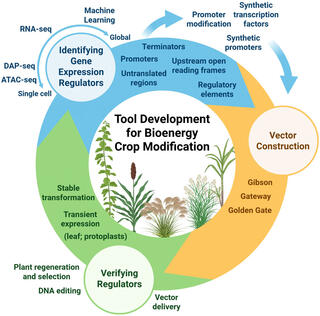Mapping advances and bottlenecks on the path to engineering bioenergy crops

Background/Objective
Regulatory elements (REs) controlling organ, tissue, and cell-type specific expression are critical for precision engineering. New technologies and improvements to conventional methods have advanced the engineering of bioenergy crops but also exposed challenges.
Approach
This work reviews the current landscape of plant genetics through the lens of bioenergy crops to present a roadmap for using DNA-based tools to engineer improvements.
Results
Advanced technologies in single cell analytics boost promoter identification at unprecedented resolution. Global identification of genomic regions harboring potential REs, integrated with in vitro mining of transcription factor binding sites are accelerating discoveries. Combinatorial sets of high-quality annotated genomic and transcriptomic data are a potential gold mine for machine learning and artificial intelligence to discover new functional units of REs and transcription factors (TFs). Despite progress, element validation, design, building, and delivery of multi-part constructs remain a critical bottleneck as we begin to understand the profound impact of genome engineering and the need to overcome transformation limitations.
Remaining challenges include: adapting open source transformation for elite lines, heterozygous, and self-incompatible species; portability and species-agnostic tools to standardize transient expression; adapting models to accurately predict engineered crop performance in downstream processing; using synthetic REs/TFs for rational design of build-test-learn cycles; harnessing throughput and miniaturization to screen outputs of automated molecular biology and robotic analytics.
Impact
Bioenergy crops like switchgrass, sorghum, and poplar can be renewable, home-grown sources of transportation fuels and valuable chemicals used to make plastics, adhesives, medicines, and other products.
Indibi, A., et al. Through the lens of bioenergy crops: advances, bottlenecks, and promises of plant engineering. The Plant Journal, 123, e70294. (2025). [DOI:10.1111/tpj.70294]